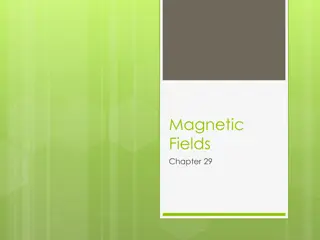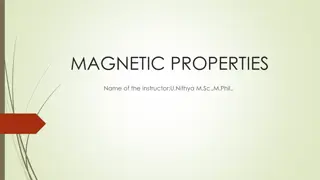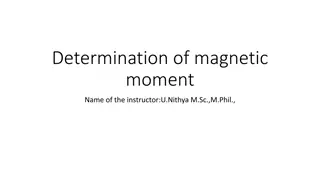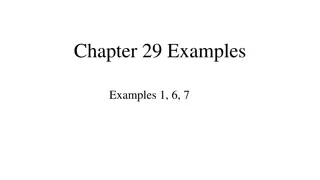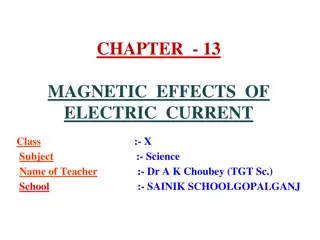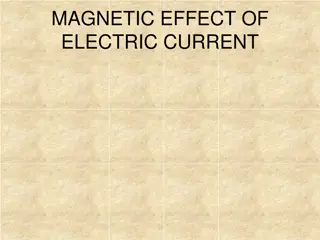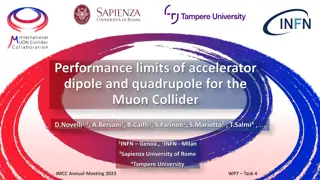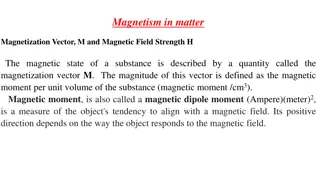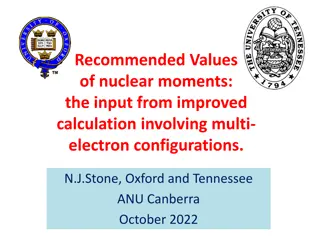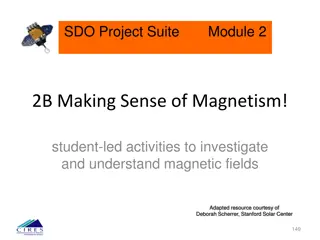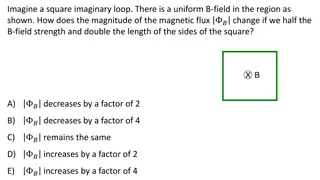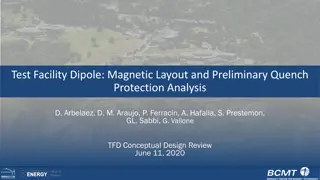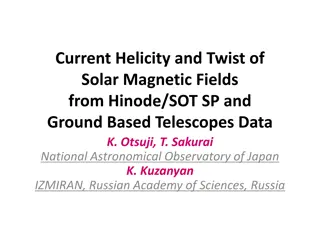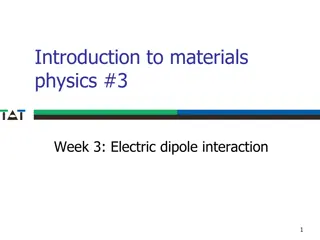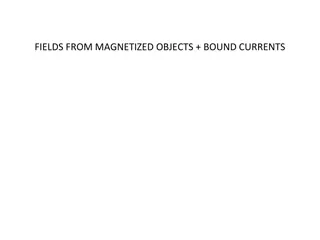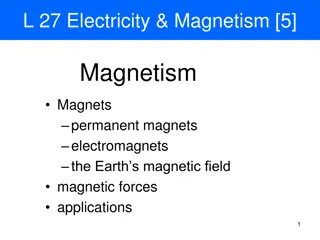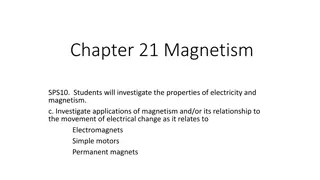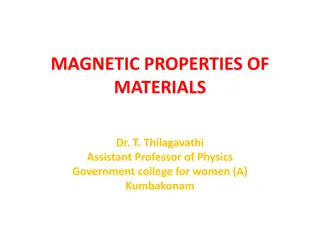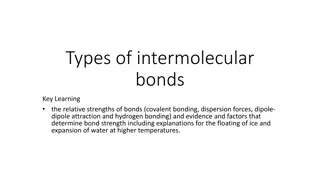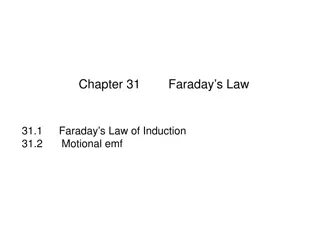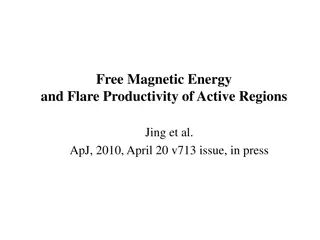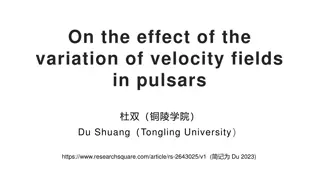Understanding Ampere's Law and Magnetic Fields in Wires
Explore the basic premise and elementary applications of Ampere's Law in calculating magnetic fields around wires. Learn how to determine the magnetic field strength at various distances from a wire carrying current, and comprehend the force between two parallel wires due to magnetic fields. Dive in
7 views • 11 slides
Understanding AGN Jet Production Efficiency: Insights from Spin and Magnetic Flux
A fundamental question in astrophysics is how efficiently active galactic nuclei (AGN) produce jets. Black hole spin and magnetic flux play crucial roles in determining the jet production efficiency. High-spin values and large magnetic flux threading are essential for generating high-efficiency jets
2 views • 22 slides
Basic Principles of MRI Imaging
MRI, or Magnetic Resonance Imaging, is a high-tech diagnostic imaging tool that uses magnetic fields, specific radio frequencies, and computer systems to produce cross-sectional images of the body. The components of an MRI system include the main magnet, gradient coils, radiofrequency coils, and the
2 views • 49 slides
Understanding Magnetic Disks and Disk Controllers in Computer Memory Hierarchy
Auxiliary memory in computer systems provides additional backup storage through technologies like magnetic disks and tapes. Magnetic disks, which consist of circular platters coated with magnetizable material, offer direct access storage and are controlled by read/write mechanisms and disk controlle
10 views • 42 slides
Exploring Magnetic Fields and Earth's Magnetism
Uncover the fascinating world of magnetic fields, from the historical discoveries of magnetism to understanding the Earth's magnetic field and its poles. Dive into the concepts of magnetic forces, field lines, and the direction of Earth's magnetic field over time. Discover the properties of magnetic
1 views • 24 slides
Understanding Magnets and Magnetic Fields
Explore the fascinating world of magnets and magnetic materials. Discover how magnets have two poles, North and South, and how they interact with each other. Learn about magnetic materials like iron, cobalt, and nickel, and understand the concept of magnetizing and demagnetizing. Dive into the magne
0 views • 15 slides
Understanding Magnetic Properties and Types of Magnetism
Explore the fundamentals of magnetic properties and types of magnetism in this detailed guide. Learn about magnetic permeability, magnetic susceptibility, paramagnetism, diamagnetism, ferromagnetism, antiferromagnetism, and ferrimagnetism. Understand the magnetic moments of spinning electrons, orbit
2 views • 28 slides
Understanding Magnetic Moments and Susceptibilities in Materials
Determination of magnetic moment and susceptibility plays a crucial role in studying the magnetic properties of materials. This involves methods like Guoy balance for paramagnetic substances and observing weight changes for diamagnetic substances. The Faraday method, employing a quartz container in
0 views • 20 slides
Unveiling the Power of Magnetic Energy in Health and Wellness
Magnetic energy, once a mysterious force, is now recognized as a vital natural energy influencing all life forms. Our bodies thrive on magnetic energy for cell rejuvenation and overall health. Bio-magnetism, an ancient practice, is gaining momentum as a promising therapy. Saarvasri introduces magnet
0 views • 8 slides
Magnetic Field Problems: Protons, Wires, and Charged Ions
Solve various problems related to magnetic fields, including determining forces on protons, calculating magnetic forces on wires with currents, finding the radius of paths for charged ions in magnetic fields, and more. Understand concepts such as magnetic forces, circular orbits, and interactions be
0 views • 10 slides
Magnetic Force and Acceleration of Electrons in Television Picture Tubes
An electron in a television picture tube is analyzed as it moves towards the front of the tube in a magnetic field. The magnetic force and acceleration of the electron are calculated, along with determining the linear speed of a proton moving in a circular orbit under a magnetic field. Additionally,
0 views • 6 slides
Understanding Magnetic Effects of Electric Current in Science Class
Explore the magnetic field and field lines, understand the magnetic effects of current-carrying conductors, learn about the right-hand thumb rule, and discover the magnetic field due to current through a circular loop in Chapter 13 of Magnetic Effects of Electric Current in Science Class at Sainik S
0 views • 17 slides
Understanding Van der Waals Forces and Intermolecular Interactions
Van der Waals forces encompass London dispersion forces, dipole-dipole forces, and hydrogen bonding, influencing interactions between atoms and molecules. London dispersion forces are the weakest and present in all molecules, dipole-dipole forces involve permanent dipoles, and hydrogen bonding, the
0 views • 9 slides
Exploring the Magnetic Effect of Electric Current
Understanding electromagnetism involves recognizing how an electric current in a conductor generates a magnetic field around it. This phenomenon was first observed by Hans Ørsted in 1820, leading to discoveries about magnetic field patterns for various conductor shapes. By studying straight wires,
0 views • 30 slides
Determination of Dipole Moment in Chemistry
The determination of dipole moment in chemistry involves methods such as the Temperature Method (Vapour Density Method) and Refractivity Method. These methods rely on measuring various parameters like dielectric constants and polarizations at different temperatures to calculate the dipole moment of
1 views • 15 slides
Understanding Mass Spectroscopy and Magnetic Sector Design in MS
Introduction to Mass Spectroscopy (MS), key physics effects, magnetic sector MS design considerations, measuring mass/charge ratio, and using derived principles to scan a magnetic sector MS. Learn about the historical development of magnetic sector mass spectrometers and the first recorded MS spectr
0 views • 14 slides
Performance Limits of Accelerator Dipole and Quadrupole for Muon Collider
Utilizing Python code, the study analyzes the limits of accelerator dipole and quadrupole for the Muon Collider. Analytic formulas are implemented to assess the behavior of these components based on critical current density, operating temperatures, and superconductor materials. The study explores li
0 views • 17 slides
Understanding Magnetism in Matter: Magnetization and Magnetic Field Strength
The magnetic state of a substance is characterized by the magnetization vector M, representing the magnetic moment per unit volume. The total magnetic field induction at a point within a substance depends on the applied field and magnetization M. Substances can be classified as paramagnetic, ferroma
2 views • 11 slides
Understanding Magnetic Forces in Electric Motors
Explore the intricate relationship between magnetic forces, current-carrying conductors, and electric motors with detailed explanations and visual aids. Discover the principles behind Fleming's left-hand rule, the directional relationship of current and magnetic field, and the motion of current-carr
3 views • 20 slides
Insights into Nuclear Moments and Corrections in Magnetic Interactions
Recommended values of nuclear moments are crucial for understanding magnetic dipole moments in multi-electron configurations. The hierarchy of reference moments establishes strength in magnetic interactions, with corrections to raw experimental data such as diamagnetic corrections being essential fo
0 views • 15 slides
Understanding Magnetic Fields Through Student-Led Activities
Explore the fascinating world of magnetism with student-led activities to investigate and comprehend magnetic fields. Discover the properties of magnetic poles, observe magnetic field lines, and learn about the history and significance of magnets on Earth. Engage in hands-on experiments and discussi
0 views • 12 slides
Understanding Magnetic Flux and Induced Current in Loops
Explore concepts related to magnetic flux and induced current in loops through visual scenarios involving uniform magnetic fields, loop movements, and changes in magnetic flux. Test your understanding with multiple-choice questions on induced EMF, loop bending, and maximizing magnetic flux. Enhance
1 views • 54 slides
Renormalization Group Analysis of Magnetic Catalysis in Quantum Field Theories
Explore the phenomenon of magnetic catalysis in strong magnetic fields through a renormalization group analysis, drawing parallels to superconductivity and dimensional reduction. Discuss the impact of IR dynamics on nonperturbative physics like superconductivity. Delve into Landau-level quantization
0 views • 21 slides
Test Facility Dipole Magnetic Layout & Quench Protection Analysis
This presentation discusses the magnetic layout and preliminary quench protection analysis for the Test Facility Dipole. It covers conductor assumptions, critical current density scaling, and HEPdipo block coil designs, including graded and non-graded options. The goal is to achieve higher performan
0 views • 22 slides
Understanding Magnetic Damping in Conducting Solids
When a conductive solid moves through a magnetic field, eddy currents are induced, creating an interaction that leads to magnetic damping. This phenomenon, known as magnetic damping of vibrating conducting solids, plays a crucial role in various applications and can be analyzed using tools like COMS
0 views • 9 slides
Statistical Analysis of Solar Magnetic Fields from Hinode/SOT SP Data
Statistical analysis was conducted on solar magnetic fields using data from the Hinode/SOT SP and ground-based telescopes. The study examined current helicity, magnetic twists, and helical parameters, revealing hemispheric sign rules and variations based on field strengths. Results show different he
0 views • 13 slides
Understanding Electric Dipole Interaction in Materials Physics
Dive into the world of electric dipole interaction in materials physics, exploring topics such as electromagnetic wave properties, force acting on electric dipoles, potential energy calculations, and the representation of waves through phasors. Learn about the differences between electromagnetic wav
0 views • 22 slides
Basics of Compass Surveying and Magnetic Bearings
Compass surveying involves the use of compasses to determine directions and bearings during surveying activities. This method utilizes tools like prismatic compasses and magnetic needles to establish true and magnetic meridians, as well as arbitrary and grid meridians. Understanding concepts like wh
0 views • 17 slides
Understand Magnetic Fields and Currents in Solids
Explore the concepts of magnetic fields and currents in solids, including the calculation of magnetic dipole moments, the presence of bound currents in cylinders with uniform magnetization, the distribution of bound currents on different surfaces, and the behavior of magnetic fields in solid cylinde
0 views • 14 slides
Update on Dipole Model Targets for MDP General Meeting May 17, 2017
The update covers the targets and specifications for the MDP 16 T Dipole model discussed during the general meeting on May 17, 2017. It includes details such as magnet dimensions, conductor specifications, operational parameters, geometrical field harmonics, coil stress, and more. The objectives and
0 views • 11 slides
Understanding Magnetism: From Permanent Magnets to Electromagnetism
Explore the fascinating world of magnetism, covering topics such as permanent magnets, electromagnets, Earth's magnetic field, and the applications of magnetic forces. Discover how magnets work, the properties of permanent magnetism, and the relationship between magnetic and gravitational fields. De
0 views • 25 slides
Understanding Magnetic Particle Testing in Industry
Magnetic Particle Testing (MT) is a non-destructive method used to detect discontinuities in ferromagnetic materials by applying finely divided magnetic particles. This method, popular in industries like automotive, aerospace, and petrochemical, involves magnetization of the material, application of
0 views • 25 slides
Exploring Magnetism: Properties, Forces, and Applications
Investigate the properties of magnetism, magnetic forces, magnetic fields, and magnetic materials. Understand how magnetic forces work, the behavior of magnetic fields, and the significance of magnetic materials such as ferromagnetic substances. Explore applications like electromagnets, simple motor
0 views • 19 slides
Understanding Magnetic Properties of Materials in Physics
Explore the magnetic properties of materials through concepts such as basic magnetism, hysteresis, electromagnetic force, permeability, coercive force, and magnetic flux density. Delve into the study of magnetic fields, lines of force, and their applications in various engineering materials and magn
0 views • 17 slides
Understanding Bubble Size Distribution Using Magnetic Particle Tracking
Explore the methodology of determining bubble size distribution in fluid beds through Magnetic Particle Tracking (MPT). Learn about MPT key features, information obtained from 3D trajectory data, and the application of MPT for characterizing fluidized solids behavior. The usage of magnetic tracers a
0 views • 24 slides
Exploring Intermolecular Bonds and Relative Strengths
Understanding the types of intermolecular bonds - covalent bonding, dispersion forces, dipole-dipole attraction, and hydrogen bonding, along with their relative strengths and factors determining bond strength. Learn about permanent dipole-dipole forces and hydrogen bonding, crucial for phenomena lik
0 views • 18 slides
Understanding Faraday's Law of Induction and Lenz's Law
Faraday's Law of Induction states that a changing magnetic field induces an electromotive force (emf) in a conductor, producing an induced current. Lenz's Law complements this by determining the direction of the induced current to oppose the change in magnetic field. This phenomenon is demonstrated
0 views • 23 slides
Understanding Magnetic Resonance Imaging (MRI)
Magnetic Resonance Imaging (MRI) is an imaging technique based on nuclear magnetic resonance principles. It was first developed in the 1970s by Paul Lauterbur and Peter Mansfield. MRI uses the interaction between protons in the body and magnetic fields to create detailed images. This technology has
0 views • 77 slides
Understanding the Relationship Between Free Magnetic Energy and Solar Flare Productivity
This study examines the correlation between free magnetic energy and flare productivity in active regions on the Sun. By analyzing data from solar events and magnetic field observations, researchers investigate the temporal variation of free magnetic energy and its impact on flare occurrence. Variou
0 views • 12 slides
Impact of Velocity Field Variations on Pulsar Magnetic Fields
The study explores how variations in velocity fields affect pulsar magnetic fields, highlighting the conversion of kinetic energy to magnetic energy in pulsars. Glitches in these systems can lead to changes in magnetic fields, influencing pulsar emissions. The maintenance of stable magnetic fields a
0 views • 14 slides




